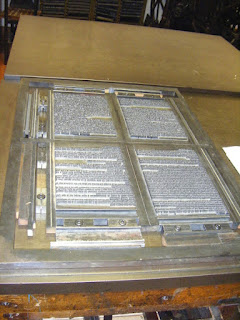The book is finally ready to go to the printer’s, word-perfect and with a beautiful cover. This is where it finally becomes an object that many people can hold in their hands and read. Nowadays typesetting is computerised and printing is mechanised. We are all typesetters, converting our thoughts into letters on our phones and laptops, choosing the typeface we want to use. But let’s have a look at how it worked before computers.
For hundreds of years books or scrolls were written by hand, for example the 7th century Lindisfarne Gospels and the 9th century Book of Kells.
These books were very beautiful, but only a few people could read or own them so of course they were very expensive.
A way of printing from stamps began in China in the 5th or 6th century and mass printing from woodblocks in 907. In Europe, woodblock printing goes back into the 14th century. Each page was carved onto a woodblock and then printed. This happened in Europe too.
A woodblock
This made it possible to print many copies very much more quickly, but the process of carving the woodblock was still very slow.
A woodblock print
Printing was really revolutionised with the invention of moveable type. Again it was first invented in China in the 11th century, with individual characters made out of clay, and in Europe in the 15th century with letters of metal.
Type
When I was young I worked as a typesetter in a printing works that had somehow managed to stay in the nineteenth century.
The frame where the typsetter stands, with cases of type below.
All our type was movable, and to set it we used a stick
A compositor’s stick
The letters sit on little metal shelves called leads to sandwich them together. When a block of text is ready it can be tied up and put in a galley. When the whole page is ready it is all assembled on the ‘stone’ using different sized pieces of wood and metal, called ‘furniture’. Eventually this is all screwed tightly together in a metal frame, the ‘chase’, and can then be lifted onto the press.
The forme on the stone, ready to print
My experience has been very handy for the book I am writing, which takes place in a printing works in the 1800s. Here is my character’s name, set in capitals with a print from it.
When books are printed, several pages are printed on one large sheet and then cut and folded. This is a tool for folding so that the edges are crisp – it’s called a bone.
The pages could be put together and sewn in bundles before being bound with a cover made of cardboard, leather or cloth. They would then be pressed in a bookbinding press like this one.
A bookbinding press
19th century books were sometimes sold with the edges still folded so that the reader would have to cut the pages to open the book.
Modern printing is completely different from the old days of hand or foot operated presses.
But we can find traces of the old ways – in the words: upper case and lower case, typesetting, the spacebar on a computer which comes from the old spacers that were put between letters, and most of all, if you hold a new hardback book up to your nose you can still capture the delicious smell of ink.
children and young adults -
Susan Brownrigg, Barbara Henderson, Catherine Randall,
Ally Sherrick and Jeannie Waudby.
and a youtube video with a writing challenge for young people and teachers.














No comments:
Post a Comment